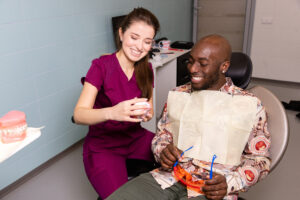One of the most common questions we get asked is: “What is the difference between plaque and tartar?”
Have you ever noticed that when you leave the dentist office your teeth feel smooth and clean and 15 minutes later they feel dingy again? What you are feeling is called salivary pellicle. Salivary pellicle is a layer of glycoproteins from your saliva that form on your teeth seconds after they are cleaned. Your body does this to help protect your teeth.
Plaque is a sticky, bacteria-filled film that constantly forms on the teeth by binding to the pellicle. With regular brushing and flossing, it can be kept under control (you’re literally washing and brushing the bacteria away). Left unattended, plaque hardens or calcifies and becomes a more troublesome substance called tartar or calculus. Tartar adheres to tooth enamel and is impossible to remove by brushing alone.
What makes tartar so problematic is that it prevents you from washing away the plaque bacteria (or plaqteria), allowing it to remain close to your teeth and gums resulting in cavities and gum disease. The more of it you have on your teeth, the more time you need to be in the dentist’s chair as the hygienist removes it.
The reality is that you’ll never be able to avoid plaque. Another reality is that your mouth will never be bacteria free. But with regular brushing, flossing and visits to the dentist, you can definitely prevent tartar from forming or certainly minimize it, and that’s the best thing you can do for your teeth.








